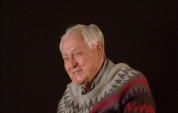3:08 | John Hancock outlines his trajectory through Navy flight school and the different aircraft he progressed through on his way to being a fighter pilot. When he got back to the war, he flew the Grumman F6F Hellcat from the deck of a brand new carrier.
Keywords : John Hancock Taylorcraft Boeing-Stearman PT-17 Vultee BT-13 Valiant North American T-6 Texan (SNJ) torque USS Bon Homme Richard (CV-10) USS Yorktown (CV-10) Fighter Squadron VF-54 Grumman F6F Hellcat Vought F4U Corsair

Along with a friend, John Hancock enlisted in the Navy in 1941. He had been smitten with a recruiting billboard featuring a Navy aviator. The pair were in training when Dec. 7th church services were interrupted for a news bulletin.
John Hancock got used to life aboard the carrier Yorktown as she cruised from Norfolk to San Diego. He was a latecomer to the crew so he had a hammock instead of a bunk. Once the ship got to the Pacific, its planes joined in the first retaliatory strike against the Japanese in the Marshall and Gilbert Islands.
The carrier Yorktown joined the Lexington near Australia in an effort to keep the supply lines to Gen MacArthur's forces open. When the Japanese sent a task force their way, the Battle of the Coral Sea ensued. John Hancock was manning a machine gun on the deck of the Yorktown and he fired so much he burned out the barrel.
During the Battle of Midway, John Hancock saw the sky filled with a million tracers. The machine gunner could not tell if he'd hit any of the Japanese planes, but he kept firing from the deck of the carrier Yorktown. He was knocked down when bombs hit the ship and when the torpedoes hit, the order went out to abandon ship.
John Hancock describes the experience of torpedoes hitting his ship at the Battle of Midway. Though it was close to sinking, the abandon ship process was orderly because of all the drilling. He didn't even know he had shrapnel wounds and a collapsed lung until after he was rescued from the water.
After surviving the sinking of the Yorktown during the Battle of Midway, John Hancock realized a lifelong dream and went to flight school. He had been a lowly seaman on the Yorktown but he returned to the war as a fighter pilot.
There were Japanese radio antennas on Chichi-jima that needed to be destroyed. John Hancock recalls the downing of an American plane during that operation which was piloted by a future president. From there, his fighter squadron and carrier participated in the retaking of the Philippines.
It was fighter pilot John Hancock's job at Iwo Jima to keep the kamikazes off the ships. They came in huge waves, but they were slow and easy to hit. The pilots still caused a lot of damage because they were determined to die to achieve it.
The sinking of the Yamato off Okinawa was the coup de grace for the Japanese Navy. Fighter pilot John Hancock recalls the hair raising moments trying to bring down kamikazes. It took him years to forget about it after the war, but then he began speaking about it.
Near the end of the war, fighter pilot John Hancock would escort B-29's to Japan and then cut loose to create mayhem on the ground with his machine guns. He returned to Hawaii to begin training in F-4U Corsairs and one day, he heard so much noise he thought the Japanese were bombing Pearl Harbor again.
Fifty years after the Battle of Midway, John Hancock was at a commemoration event that was also attended by some Japanese veterans. He went up and introduced himself to one of them and was in for quite a surprise.
John Hancock explains why the Navy can lay claim to being on Guadalcanal months before the Marines landed. It had to do with two pilots who were low on fuel and who were reprimanded for the incident.
They had joined the Navy together and were serving on the Yorktown during the Battle of Midway. John Hancock saw the bomb falling that hit his friend Clarence Hill's gun mount. He looked down to the lower deck to see what happened and he wished he had not.
In college after the war, John Hancock was asked if he wanted to join the Navy Reserve. The veteran Navy pilot said he hated the reserve. Then he was told it paid money. Where do I sign? A long career followed alongside his successful working life.